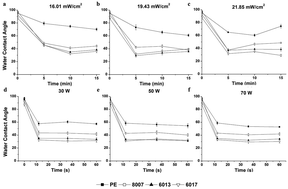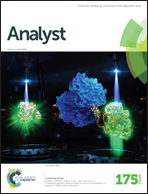Characterization of activated cyclic olefin copolymer: effects of ethylene/norbornene content on the physiochemical properties†
Abstract
The ethylene/norbornene content within cyclic olefin copolymer (COC) is well known to affect the chemical and physical properties of the copolymer, such as the glass transition temperature (Tg) and transparency. However, no work has been reported evaluating the effects of the ethylene/norbornene content on the surface properties of COC following UV/O3 or O2 plasma activation. Activation with either O2 plasma or UV/O3 is often used to assist in thermal assembly of fluidic devices, increasing the wettability of the surfaces, or generating functional scaffolds for the attachment of biological elements. Thus, we investigated differences in the physiochemical surface properties of various ethylene/norbornene compositions of COC following activation using analytical techniques such as water contact angle (WCA), ATR-FTIR, XPS, TOF-SIMS, UV-VIS, AFM and a colorimetric assay utilizing Toluidine Blue O (TBO). Results showed that increased norbornene content led to the generation of more oxygen containing functionalities such as alcohols, ketones, aldehydes and carboxyl groups when activated with either UV/O3 or O2 plasma. Specifically, COC with ∼60% norbornene content showed a significantly higher –COOH functional group density when compared to COC with a 50% norbornene content and COC with a 35% norbornene content following UV/O3 or O2 plasma activation. Furthermore, COC with large norbornene contents showed a smaller average RMS roughness (0.65 nm) when compared to COC containing low norbornene contents (0.95 nm) following activation making this substrate especially suited for nanofluidic applications, which require smooth surfaces to minimize effects arising from dielectrophoretic trapping or non-specific adsorption. Although all COC substrates showed >90% transparency at wavelengths >475 nm, COC possessing high norbornene contents showed significantly less transparency at wavelengths below 475 nm following activation, making optical detection in this region difficult. Our data showed distinct physiochemical differences in activated COC that was dependent upon the ethylene/norbornene content of the thermoplastic and thus, careful selection of the particular COC grade must be considered for micro- and nanofluidics.

- This article is part of the themed collection: In memory of Craig Lunte


 Please wait while we load your content...
Please wait while we load your content...